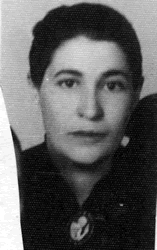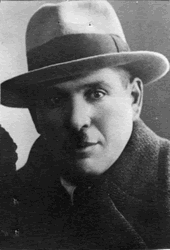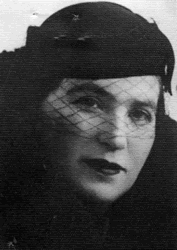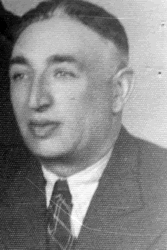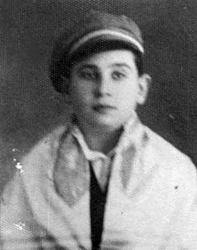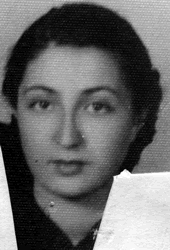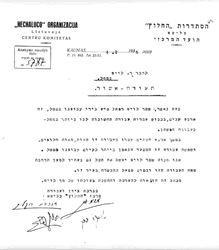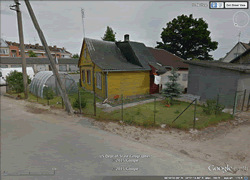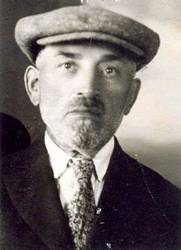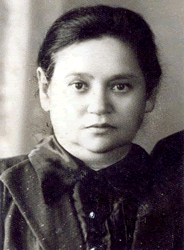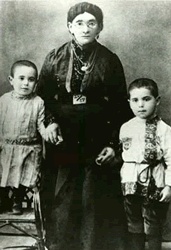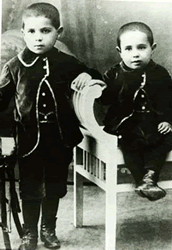and Postavy.
Four brothers, Abraham, Louis, Saul and Samuel, emigrated and settled in
Carteret, NJ. Their sister Sarah (Sora) married Harry GOZ and lived in Ohio
and then Carteret,NJ. Their sister Sophie married Samuel WEXLER and also
settled in Carteret, NJ.
Somewhere between 1925 and 1930 they brought their father Itzhak (born about
1854) to NJ from Kurenitz, where he was then living.
Family lore has it that there were at least 6 other children, some of whom
came to the States and settled in other locations. Other relatives lived in
Ponevezh.
If any of these names or locations sound familiar, I look forward to hearing
from you.
Stephanie Weiner
born c 1859 and died c. 1904, married Sora (Sadie/Hassa) FARB, born c.
1864 and died c. 1918 possible in Crimea from the plague. As far as I
know they were from Panevezys, Kovno, Lithuania.
They had at least 6 children:
Samuel (Shumel ben Nissan) Evens born c. 1897 (my Zeida) married Pearl
Kramer in Krugersdorp
Yossel/Joseph Evans who married Alka Katz
Hescel/Hessel Evian/Evans who married Henna. He died in Krugersdorp
Hinda Ruchel Evens born c 1892 who married Karpel Gulin,
Yockel/Jockel/Jokkel Evans born c. 1889 who married Sarah/Sora
Morris/Maurice b. c 1891 who died during WW1. It is possible that his
wife and 2 of his children were shot dead while running away from the
front line
All, except for Hinda and possibly Maurice, emigrated to South Africa.
Hinda emigrated to USA and I have her family history. I am missing
information on her son Nissan who was at Odessa in a Yeshiva when the
rest of the family emigrated to America. He later emigrated to
Argentina
I have a full history of my Zeida's line and some information on his
sibilings. But I know nothing about his parents.
Hoping someone can help me with information or suggestions on this
family
Michelle
EVIAN/EVENS/EVANS/EWAN (Lithuania, South Africa, UK, America, Israel)
FARB (Lithuania, South Africa, UK, America, Israel)
KRAMER (Lithuania, South Africa, UK, America, Israel)
GREEN (Lithuania, South Africa, UK, America, Israel)
JACOBSON (Lithuania, South Africa, UK, America, Israel)
Whilst in Panevezys, I met with Genadij Kofman, Chairman of the Jewish
Community, who told me the story of the Panevezys Jewish Cemetery, where
at least four of my family are buried. What once was The Cemetery is
now a park. The only acknowledgement that this once was a Jewish Cemetery
being a small stone with almost unreadable writing.
In 1956 the Soviets stopped any more burials, and then several years
later totally demolished the cemetery, the headstones being used for
building roads, walls and some even incorporated into the wall of a
theater. Genadij then showed me the tremendous work he has been doing
to have a beautiful monument erected in the park, incorporating some
of the old headstones which he has managed to get the Panevezys City
Council to remove from the theater. This is now at a stage where the
Panevezys Jewish Community and City Council are almost ready to start.
Being so impressed with the work Genadij was doing, I committed my
family to supporting the project and also to see what further I could
do to help. I have some old photos of The Cemetery, plans for The
Memorial, an article (in English) which Genadij has recently written
for the Jerusalem of Lithuania Newspaper and other material, all of
which I would be delighted to share.
Keith W Kaye MD. Minneapolis, Minnesota.
of R' Chaim of Volozhin and author of "Menuchah U'kedushah." I am
particularly looking for a last name and a date of death.
Shlomo Katz
Internal Passport Project another 401 records. This makes a total
of 7,025 records distributed to the donors thus far. More records
remain to be translated. If you are not already a donor to the
Panevezys I.P. Project, you can receive all of the translated
records merely by making a $100 contribution, specified for the
Panevezys Internal Passport Project. Go to
http://www.jewishgen.org/JewishGen-erosity/ You can use your credit
card as the site is secure. To see a full description of Internal
Passports, and to view images of original records, go to
http://www.jewishgen.org/databases/Lithuania/InternalPassports.htm
Just because your ancestors left Lithuania before 1915, it does not
mean these 1919-1940 records hold no interest for you. Your immediate
family may have left but, in most case, other family members and
relatives remained there. In 1915, the majority of the Jews in
Lithuania were forced to go deep into the Eastern part of Russia.
After 1919, most of those Jews returned to Lithuania and had to
apply for an Internal Passport. Many researchers have had great
success with the Internal Passport records.
Every time I receive another group of translated Internal Passport
records, it never ceases to amaze me about the outstanding information
presented. Several examples from this group of Panevezys records will
illustrate my point.
(1) Leib NEMAS / [NEMM], son of Yankel. Born 1877 in Baisogola. Applied
for his Internal Passport on 14 December, 1921. (This is an indication of
the date he returned to Panevezys from Russia because he had to apply
within 30 days of his arrival back in Lithuania). He lived at Ramygalos
st. 60 in Panevezys and was a Merchant. He was married. He died 18 July
1927. His Military Service Certificate Nr. 5151, issued in Siauliai in
1899 and his Internal Passport are in the file. His wife was Hinda
FARBERAITE / [FARBER] born in 1883, daughter of Yovel. They had three
children - Yosel - Born 1908, Tauba - Born 1909, and Rakhel - Born 1914.
(Baisogola, Panevezys, Siauliai - you can see the possibilities this
opens up to find more records. Also, his Military Service Certificate
may offer the information needed to find his Russian military records).
(2) Basia MILSTEINAITE / [MILSHTEIN], daughter of Abraham and Rebecca.
Born 1903 in Vilnius. She was single when she applied for her Internal
Passport 28 August 1920. (Upon reaching the age of 17 she had to apply
for her own Internal Passport). She lived with her parents at Kranto st.
10 in Panevezys. Her mother's maiden name was BIGELYTE / [BIGGEL] and
she was born in 1869 in Vidzai, Ezerenai Uyezd. Her father was born in
1868 in Vidzai, Ezerenai Uyezd. He was a carrier. The German passports
for Basia and her father were issued 29 May 1916 in Vilnius and her
mother's German passport was issied in Panevezys 19 May 1917. All three
German passports are in the file. Basia got married to Hirsh DOLBERGAS /
[DOLBERG] on 8 August 1926 in Kaunas. In addition to Basia, Abraham and
Rebecca had three sons. Alter - born 1908, Shimon - born 1911, Jacob -
born 1913. (Again, the records not only provide a wealth of information
but also present an opportunity to do further research in the records for
Vidzai, Vilnius, Panevezys, and Kaunas).
Howard Margol
Coordinator, Internal Passport Project 1919-1940
My name is Vlad (Elad) Grausbard. I am engaged in search of archival documents on my ancestors.
My father Grausbard Efim (Haim) ben Yakov was born in 1941. My grandfather Grausbard Yakov Mihajlovich (Haim-Lejzerovich) was born in 1903 in Bolshoy Tokmak Taurian Province in Ukraine. His father, my great-grandfather, Grausbard Haim-Lejzer ben Zelik (approximately 1860 of a birth) was born and lived in Lithuania. His father Zelik Grausbard. On site contemporary records www.jewishgen.com I managed to find some families with mine a little a modified surname (Grauzbord, Grausbord, Grayzbard, Grausborg. Groysbard), but, having analyzed all data from base, I have come to conclusion, that a different writing of surnames are formed at the same family. There is there an information with names Leizer and Zelik, the surname coincides. I have made the big family tree, on a tree the basic cities of stay and moving of ancestors are traced. Basically it is cities of Vilkija, Luoke and Panevezys. The basic Forefather at all sample by an ancestor was TSALKO (TSALEL). Please, I can-whether count on your help, what from me it is necessary? Me any archival information on my ancestors interests.
It is in advance grateful for your help and your answer.
With best wishes,
Vlad Grausbard
General Director
"RENDERMEDIAPRODUCTION"LLP
050002, Kazakhstan, Almaty,
Zhibek Zholy st. 50 #915
tel./ +77272718451
tel/fax./ +77272718459
mob./ +77772990858
vlad@render.kz
www.render.kz
LANE of Philadelphia) mentioned to me that GREENWALD was related to the LANE
family.
I found a connection in the 1910 Census for Philadelphia. Do you recognize
any names?
The 1910 Census shows the Samuel LANE family from Panevezys, with wife
Annie, and children Bella, Sarah, Dora (known also as Dot), David, Philip,
Gertrude, Edith, and Bertha (known as Bea or Beatrice) living at the same
address as the GREENWALD family. Family information says that Bella (Belle)
married KOMINS, Dot married KESSEN, and Gertrude married HIRSHORN.
The GREENWALDs included Julius and Louisa, and their children Olga, Reinold
and Lydia.
Please send family information to me directly.
Jeff Miller,
Maryland
Researching:
LAN, LANE, WIENER, YUDELOWITZ from Panevezys, Lithuania
BLANKFORT, BLANKFURT, WHITEMAN/WEITZMAN/WEISSMAN from Lithuania, United
Kingdom and Canada, and the United States
SPEKTOR/RABINOWITZ with connection to R. Yitzhak Elchonan SPEKTOR
HIRSHORN, GREENWALD, LANE, KOMINS, KESSEN from Philadelphia
recorded in 1892 as three men in a family with the name of Izvoshchik, box tax payers, living on a farm outside the city. They were cabmen, and one of them could have been, or been related to, my grandfather, whose provenance I have been struggling for years to find. I have the reference number of the record but don't know how to proceed from here, and would be most grateful for help.
Betty Gardiner.
From: Jeff Miller
To: LitvakSIG <litvaksig@lyris.jewishgen.org>
With the amazing help of Genners I've learned that my LANE family from
Panevezys included Hyman LANE (not Max) as the head of household and wife
Sarah, children Rebecca, Abraham and Lena. I greatly appreciate the
assistance of Genners and have separately sent my appreciation notes to
those who responded to my previous posting.
The Hyman LANE family dropped out of the Harrisburg City Directories after
1920, and showed up in the Census in Philadelphia in 1930, and listed their
country as Lithuania (earlier information placed them in Panevezys). And
they all put year of immigration at 1910 this time (earlier records
indicated that Hyman arrived in 1904-1905 and the rest of the family came in
1906 through Baltimore -- the names have been connected form the manifest to
the Census records where Simch became Sarah, Abram as Abraham, Beile as
Rebecca, Sabse as Samuel, and Seil or Leil as Lena).
There are two marriage records (using familysearch.org) for women named Lena
Lane in the Philadelphia Marriage records, one with JONES 1941, and one with
a Henry HOROWITZ in 1931. There are also marriage entries for men named Sam
or Samuel LANE (to women with surnames GREEN, FABERMAN, and KELLY), Sarah
(one to a FISHER and one to a PALMER) and for Abraham LANE.
In the 1930 Census for Philadelphia:
Hymen Lane 51
Sarah Lane 50
Abraham Lane 26
Lena Lane 23
Related families in Philadelphia at about the same time included a brother
of Hyman LANE named Sam (Samuel) and his son David LANE and other family
members; in the 1910 Census: Samuel, wife Annie and children Bella, Sarah,
Dora (Dot), David, Philip, Gertrude, Edith, and Bertha (Bea), were living at
the same address (xxxx Frankford Ave.) as a GREENWALD family. Family
information informed me that Sam's daughters Bella later married KOMINS, Dot
married KESSEN and Gertrude married HIRSHORN. This confirmed that the "first
cousins" of Isadore LANE, living also in Philadelphia at the time, were
children of the Samuel and Annie LANE I'd found in the 1910 Census (Isadore
was descended from my New York LANE family).
In addition, the 1920 Census included David LANE as a 23-year old sheet
metal worker, wife Mollie, and children Marv and Ethel. Bea, the only
surviving child of Samuel, is now age 100.
I'm seeking assistance identifying descendants of the Hyman LANE family.
A listing of files of Jewish prisoners detained in Lithuanian prisons
between the two World Wars for communist activities has been added to
the Panevezys District Research Group's data on its Shutterfly
website. The list of Jews is composed of 1357 names out of a total of
around 4200 prisoners. The list is composed of persons from all of
Lithuania, not just the Panevezys District. In addition to the name of
the prisoner , files contain additional information on each prisoner,
such as place of birth, age, father's name, place and details of
arrest, and in most cases photographs (right and left profiles and
front view), and the file number.
This listing of Jewish prisoners represents slightly more than 32% of
the total, whereas Jews represented only about 7% of the Lithuanian
population during the inter-war period. The Lithuanian Communist Party
membership ranged between 650 in 1930 and 1741 in 1940, so it appears
that probably a much smaller number of Jews who were detained were
party members, and that many Jews may have been associated with fellow
traveler organizations such as the Bund or the Labor Zionists. Many
Jews were attracted to Communist ideals which stressed equality of all
ethnic groups, freedom from discriminatory treatment under law, and
the dignity of labor, though not necessarily to the economic goals
that subsequently became paramount.
Lithuania was not unique. Jews participated in communist activities in
most of the countries of Eastern Europe between the wars (with the
possible exception of Albania), and in many cases represented the
vanguard of Soviet domination of those countries after WWII. It should
be noted that these were not religious Jews for the most part, but
Jews by birth or by "nationality" as defined by local laws or custom.
Some examples were Markus Wolf in East Germany (DDR); Slansky and
Clementis in Czeckoslovakia; Rajk, Rakosi and Gero in Hungary (where
in 1956, seven of eight members of the Central committee were Jews);
Kostov and Zhak Natan in Bulgaria; Ana Pauker in Rumania and Moshe
Pijade in Yugoslavia. Jews founded the Communist Parties in Hungary
(Bela Kun) and Greece (Avraam Benaroya). The anti-Semitic purge begun
by Stalin in 1952, just before his death, was completed in 1956 at the
time of the uprisings in some of these countries.
For anyone who finds the name of a relative on this list, in order to
obtain more details about the prisoner, it will be necessary to obtain
a copy of the complete file from the Lithuanian State Archives in
Vilna.
These data will be made available to contributors to the Panevezys
District Research Group for a period of at least 18 months before they
are added to the All Lithuania Database (ALD). Since these data are
being made available also to contributors to other LitvakSIG district
research groups, contributors to any of those groups may wish to check
first to see if these data are already available on one or more of
their Shutterfly websites. Membership in the Panevezys District
research Group necessitates a contribution of at least $100, although
smaller contributions are always welcome. All contributions are used
to pay for translations of original records and may be made on-line at
www.litvaksig.org/contributions
Shavuah Tov,
Bill Yoffee
Panevezys District Research Coordinator
kidsbks@verizon.net
A list of 1,664 Jewish prisoners in Lithuania between the two World Wars has been added to the Panevezys District Research Group's Shutterfly website.
This completes the listing of 1357 prisoner out of a total of about 4,200 prisoners that was added previously. All but eight of the persons on this new list were charged with Communist Activity. The exceptions were charged with larceny (2), foreign currency speculation (3), passport forgery (1) and illegal border crossing (1). Slightly more than 30% (514) of the prisoners were listed as females. A number of family groups are also listed: 26 male-female siblings, 136 pairs of brothers, 24 pairs of sisters, 10 spouse couples, one case of 4 sisters, three cases of 3 sisters, four cases of 4 brothers, and several cases of parents and a son or daughter. The sentences cover a wide range of lengths, but there does not appear to be any consistency with the charges. The prisoners listed come from all parts of the Lithuanian Republic.
A majority of the prisoners were charged as members of the Communist Party. A large number were charged with specific activities relating to the Party's program or its organizing efforts, but not with membership. One person was charged for being a member of the Bolshevik faction of the Party, and one person was charged with being a "Sionist Socialist".
The official list is composed of Lithuanian surnames (with appropriate suffixes for males and females). However, bracketed [ ] next to the Lithuanian surname is the Jewish surname. Based on the given names that are listed, it appears that all those prisoners listed were ethnically Jewish even though the Lithuanian surname and the Jewish surname do not appear to be consistent. In most cases the prisoner's file is noted to include a photo, and in many cases the prisoner's Internal Passport number is listed. This may assist in locating the correct Internal Passport among those in the IPP Project coordinated by Howard Margol. For anyone who finds the name of a relative on this list, in order to obtain more details about the prisoner, it will be necessary to obtain the complete file from the Lithuanian State Archives in Vilnius.
These data will be made available to contributors to the Panevezys District Research Group at least 18 months before they are added to the All Lithuania Database (ALD). Since these data are being made available to other LitvakSIG district research groups, Contributors to any of those groups may wish to check first to see if these data are already available on one or more of their Shutterfly websites.
Participation in the Panevezys Research Group is open to anyone who makes a contribution of at least $100 to help finance the work of the group. All contributions are used to pay for translations of original records and can be made on-line at www.litvaksig.org/contribute . For any futher information please contact me.
Regards,
Bill Yoffee
Panevezys District Research Coordinator
kidsbks@verizon.net
In the Harrisburg Patriot newspaper from 27 December 1911 was an article
about a party in Harrisburg hosted by my relatives from Panevezys Lithuania,
Mr. and Mrs. Hyman LANE, for their daughter Rebecca LANE. Others at the
party were young ladies identified as "Miss" including Bessie LOON, Tillie
BEAR, Ida BLOOM, Mary SHERMAN, Jennie KLAWANSKY, Rose ZAMMIT (ZOMMIT?),
Tillie ZAMMIT (ZOMMIT?), Rose KLAWANSKY, Lena LANE, Rebecca KLAWANSKY.
Others present included Mr. and Mrs. M (Max?) LANE, Mrs. S. KLAWANSKY,
Israel CLADE, David FREEDMAN, Mr. A. GERBER, Max SMERTZ, S. DANNOVITCH,
Charles GAUSS, L. POCKEROY, D. KLAWANSKY, Samuel LANE, Abraham LANE, and
Michael KLAWANSKY.
Some of the families listed were neighbors of the LANE family, and some may
have been known through the local synagogue or other Jewish organizations,
or family connections.
From City Directories and Census records, I know that most of the Hyman LANE
family moved from Harrisburg to Philadelphia sometime after 1920.
I'm looking for information on what happened to Hyman, wife Sarah, and their
children Rebecca, Abraham, Samuel, and Lena LANE, on who the children
married, where they lived, their families, when and where they died and are
buried.
Hyman was born about 1871 and Sarah about 1874.
Rebecca was born about 1895, Abraham I have as 18 December 1899 (based on
World War I draft registration), Samuel 12 Jul 1900, and Lena between 1902 -
1904.
Any assistance would be appreciated.
Jeff Miller, Maryland
Researching Lithuania families: LAN (LANE), IUDELOVICH (YUDELOWITZ),
BLANKFORT, WHITEMAN (WEISSMAN/VAISMAN), ZUSKIN, WIENER, SPEKTOR
The database and discussion group of LitvakSIG
(litvaksig@lyris.jewishgen.org) are hosted by JewishGen
LitvakSIG is a non-profit 501(c)3 corporation. Contributions to LitvakSIG
may be made online at www.litvaksig.org/contribute and are
tax-deductible as provided by law. Contributions may also be mailed
to LitvakSIG, Inc., c/o Eden Joachim, 41 Country Club Lane, Pomona, NY
10970. Contribution forms may be faxed to 845-623-1708. Please specify town
(for vital records) or district research group (and town of interest) for
other types of records, and include your e-mail address with your
contribution.
1.Sonia Zybowsky was born in Anikst, Lithuania in 1896 to Ieshaiahu and Mina. Prior to WWII she lived in Wilno, Poland. During the war she was in Wilno, Poland. Sonia was murdered in Wilno, Poland. This information is based on a Page of Testimony (displayed on left) submitted by her nephew.
2.Rafael Lewit was born in Anikst, Lithuania in 1888 to Yeshayahu and Mina. He was married. Prior to WWII he lived in Klaipeda, Lithuania. During the war he was in Siauliai, Lithuania. Rafael was murdered in 1945 in Muldorf, Germany. This information is based on a Page of Testimony (displayed on left) submitted by his son Yerachmiel of Haifa.
3. Chiena Lewit nee Kadeshevitz was born in Anikst, Lithuania in 1896 to David and Rakhel. She was married to Rafael. Prior to WWII she lived in Memel, Lithuania. During the war she was in Siauliai, Lithuania. Chiena was murdered in 1944 in Stutthof, Camp. This information is based on a Page of Testimony (displayed on left) submitted by her son.
4. Zoltan Zybowsky was born in Poland.. Prior to WWII he lived in Wilno, Poland. During the war he was in Wilno, Poland. Zoltan was murdered in Wilno, Ghetto. This information is based on a Page of Testimony (displayed on left) submitted by his nephew.
5. David Lewit was born in Panevezys, Lithuania in 1921 to Rafael. He was married to Luba nee Shibovski. During the war he was in Wilna, Poland. David was murdered in Wilna, Ghetto. This information is based on a Page of Testimony (displayed on left) submitted by his brother.
6.Liuba Lewit nee Shibovski was born in Vilna, Poland in 1921 to Sonia. She was married to David. Prior to WWII she lived in Vilna, Poland. During the war she was in Vilna, Poland. Liuba was murdered in Vilna, Ghetto. This information is based on a Page of Testimony (displayed on left) submitted by her cousin.
7. A report regarding the contribution of rafael levit to the Chalutz in Memel by giving jobs (jobs creator) to hundreds of Chalutzim in training.
Passport Issuance Books for Linkuva and Pasvalys
The Panevezys District Research Group (PDRG) is posting the second part of a group of lists of passports issued for the Panevezys District on its Shutterfly website. These two lists recorded passports issued for the towns of Linkuva and Pasvalys for 1914 and 1915. In the case of Linkuva, 55 passports are recorded as having been issued between 5 January and 30 June 1915, roughly coinciding with the period from the invasion of Kovna Gubernia by the German army to the expulsion of the Jews from the territory subject to hostilities to the interior provinces of Imperial Russia. In the case of Pasvalys, 355 passports were recorded as having been issued between 21 January 1914 and 2 July 1915, roughly coinciding with Imperial Russia's preparations for war and the expulsion of the Jews from the front line of battle that bisected Kovna Gubernia.
The exact nature of these passports is not clear from the information on the Excel spread sheets. They are unlikely to be international passports since those that are specifically labeled indicate that they were issued for internal movement, and they are unlikely to be the usual type of internal passports because they were issued for a limited period, in most cases for one year and in a very few cases for longer periods, up to five years. In a large number of cases they are being sent to other locations such as Riga and other parts of Courland and Russia where presumably the individual is either traveling, residing temporarily or planning to reside. The passports issued in Linkuva were issued primarily to men and only a few women. In Pasvalys they were issued to more men than women. With a few exceptions, the individuals were over age 18. The list for Pasvalys includes a number of large families.
The passports appear to be color coded, with each color related to the individual's status for purposes of military conscription. White passports, which predominate, indicate that the individual is exempt from conscription. Blue passports indicate a military rank, and pink passports indicate an individual who is subject to conscription. The significance of the red passport is unknown.
It should be noted that recent studies assert that the management of the internal passport regulations in Imperial Russia, and their application to Jews, became increasingly chaotic in this period. Within two years - in 1917 - the regulations were totally abandoned by the Provisional Kerensky Government's reforms and were not replaced by the Soviet Government until 1932. (See Avrutin, Eugene, "Jews and the Imperial State: Identification Politics in Tsarist Russia", pp184-185, Ithica NY, Cornell U. Press, 2010; and Stein, Louis, " The Exile of the Lithuanian Jews during the Fervor of the First World War (1914-1918)", parts 9 and 10, http://www.jewishgen.org/Yizkor/lita/lit0089.html ). Shortly after the end of WWI, the newly formed Lithuanian state adopted internal passport regulations lasting until the outset of WWII.
The Panevezys District Research Group invites everyone who is interested in tracing family in the Panevezys District of Lithuania before and during WWI and in the inter-war period to contribute to the effort to translate passport records and other records by sending a tax deductible (in the USA) contribution of $100 to www.livaksig.org/contribute using a credit card or by check to the mailing address listed there. Contributors will have exclusive access to any newly translated records for 18 months before they become publicly available on the All Lithuania Database. Also for five years they will have access to all translated data in the Excel format on our Shutterfly website.
Lists of surnames on both passport lists are available to ANYONE on request to me at my email address below.
Bill Yoffee
Panevezys District Research Coordinator
kidsbks@verizon.net
The database and discussion group of LitvakSIG (litvaksig@lyris.jewishgen.org) are hosted by JewishGen
...pre-1914, it seems unlikely
that much or any Lithuanian was spoken or taught in Jewish schools. My
grandmother was at the Gimnasia in Marijampole probably circa 1890. She
was fluent in Russian, Hebrew and Yiddish. She had un-accented English.
Her French and German were good enough for her to teach English Army
officers in WW1.
I never heard her mention Lithuanian, nor did any of my cousins (from
Panevesys area) who left in the 1920-1935 period.
Kind regards,
Saul Issroff
From: Bill Yoffee; Owners of Insured Property in Panevezys District 1910 (Six more)
Visit our home page at http://www.litvaksig.org
The Panevezys district Research Group is posting to its Shutterfly website a list of owners of insured real estate in six more towns in the District in 1910, and their insured value also in 1910. The towns being listed are Birzai (133 owners), Linkuva (112 owners), Pakruojis (124 owners), Pasvalys (195 owners), Pusalotas (65 owners) and Salociai (22 owners). Previously the Group posted lists for eight towns and shtetls of the District: Klovainiai, Naujamiestis, Nemunelio Radiviliskis, Smilgiai, Truskava, Krekenava Ramygala and Rozalimas. The first five of these had a relatively small number of property owners when compared with the last three and the newly posted six. These lists are significant for showing the extent of real estate ownership and give some indication of the wealth of the owners and of the Jewish community of each town. The data are in the Excel format which give the owner's surname and given name, the father's name in some cases, noting where the property is held in common (presumably with a co-owner not necessarily a spouse), street location in many cases and the value of the property in current (1910) rubles. All of the records are located in the same file at the Kaunas Archives.
The right to own real estate by Jewish residents in the Pale of Settlement was guaranteed during the reign of the liberal Czar Alexander II, and that right was subsequently extended to Jews who resided outside the Pale, especially in the major cities of the Russian Empire. However after his assassination, the succession of Alexander III and the promulgation of the May Laws of 1882, the right of Jews to own land was gradually restricted again to their place of residence in the Pale and excluded altogether from the western border lands. Even land that was leased or managed was also excluded in 1903. Jews were also prohibited from changing residence within the Pale so that they were unable to acquire land rights elsewhere in the Pale.
The stated insured value of the real estate is listed in 1910 rubles. The present consensus is that one ruble in 1910 was equal to $10 US in the year 2000. (Another suggested value based on the gold standard is that one silver ruble in 1910 equaled $0.514 US Gold). The inflation adjusted value of one 1910 ruble, therefore, was $13.37 US in 2012. From the lists of assessed values of the real estate, it can be assumed that Jews in these six towns were relatively more prosperous than the eight listed earlier. The exception was Pusalotas, apparently an agricultural town, whose buildings were listed as wooden (only three as stone). None of the property owners had property assessed as high as 5000 rubles in 1910. In Pasvalys, on the other hand, six owners had property assessed for more than 5000; the highest was 9900 rubles ($132,363 US in 2012).
The Panevezys District Research Group invites everyone who is interested in tracing family in the Panevezys District of Lithuania before and during WWI and in the inter-war period to join in our effort to have additional records translated. Access to the Panevezys District Research Group's (PDRG) Shutterfly website is available to contributors. Contributions totaling $100 or more qualify an individual, and, for the next five years, provides
access to the website, as well as exclusive access to all newly translated records for at least 18 months before they are made publicly available on the All Lithuania Database (ALD). Your tax deductible (for US taxpayers) contributions can be made to www.litvaksig.org/contribute by credit card, or by check at the address that is listed there. Please be sure to designate the Panevezys DRG as the recipient.
Lists of surnames for any of the 14 towns are available to ANYONE upon request to me.
Bill Yoffee, Panevezys District Research Coordinator, kidsbks@verizon.net
The database and discussion group of LitvakSIG (litvaksig@lyris.jewishgen.org) are hosted by JewishGen
LitvakSIG is a non-profit 501(c)3 corporation. Contributions to LitvakSIG may be made online at www.litvaksig.org/contribute and are
tax-deductible as provided by law. Contributions may also be mailed to LitvakSIG, Inc., c/o Eden Joachim, 41 Country Club Lane, Pomona, NY 10970. Please specify town(for vital records) or district research group (and town of interest) for other types of records, and include your e-mail address with your contribution.
I have at last tracked down a brother of my maternal grandmother, Fanny
Brenner, who emigrated to S Africa at the turn of the 19th century. His
name was Welwel (William) Brener. There was also another brother, Louis,
who also went to S Africa. Welwel told his grandchildren that he came
from Paneveys.
I have also been told that my grandmother was one of about 13 siblings.
My mother used to tell me they came from Vilna, but that may have been a
generalisation.
I would be open to any suggestions about how to research this family in
Paneveys.
Wendy Freebourne
-- I have hit a dead end with my ancestors in Lithuania. Three Meltzer
brothers immigrated to the United States in the mid-1880's: Samuel James
(b. 1851), Joshua (b. 1864) and Mark Charles (b. 1866, my g-grandfather).
All went on to illustrious careers in the US, so there is ample information
about them, but I have only various names of their parents and some towns
where they lived.
Records for Samuel and Mark say they were born in Traupis, but other
records say they lived in Panevezys. Although these towns are near each
other, they are in different research districts, so I don't know which I
should choose to invest in - I can't really afford the $200 to join both
research districts. Their father was a rabbi; I have seen both Simon and
Victor for his first name. Their mother's name was, variously, Theresa,
Esther or Taube and one record gives her the surname Kowars. I estimate
about 1825 for their date of birth.
I have searched the ALD for Meltzer and Kowars in both Traupis and
Panevezys without finding any records for the father and mother. Can anyone
advise me on where to focus my search for records from the mid-19th century?
Liz McCane
From: Ted Berman, PE <ted@tedbermanllc.com>
Date: Fri, Feb 27, 2015 at 12:10 PM
Thanks for the great work you do.
My name is Theodore Berman (Ted) Toviah ben Chaim Shimen. My mother and father are from Svedasai and migrated to the Americas in the 20’s. My maternal grandfather moved to Panevezys with his family circa 1920. I was able from research find the Russian inventory of Jewish properties from 1940. It listed the address of my maternal grandfather Zalman Zelikman. The record showed his address in Panevezys. By the use of Google Earth i was able to take a picture of the house. It was from here that Zalman, his wife Sara and 19 year old daughter Mina were taken to be murdered. Here is the todays picture:
Thanks again for your work preserving for history the story of our families. Thanks to the genealogical databases and modern technology we were able to obtain this remembrance. I cry every time I look at it.
Best wishes:
Ted Berman
Miami Beach, FL
Zalman Zeligman was born in Abel, Lithuania in 1886 to Yosef and Khava. He was a shop owner and married Sara nee Berman. Prior to WWII he lived in Ponovez, Lithuania. During the war he was in Ponovez, Lithuania.
Zalman was murdered in the Shoah.
This information is based on a Page of Testimony (displayed on left) submitted by his daughter Yona Tobis of Herzelia
Sara Zeligman nee Berman was born in Svedasai, Lithuania in 1890 to Zalman. She was married Zalman. Prior to WWII she lived in Ponivez, Lithuania. During the war she was in Ponivez, Lithuania.
Sara was murdered in the Shoah.
This information is based on a Page of Testimony (displayed on left) submitted by her daughter Yona Tobis of Herzelia.
Tania Uljamperl also gave reports for same family Sara Zelikman nee Birman was born in Anyksciai, Lithuania in 1900 to Zalman and Tibel. She was married Zalman. Prior to WWII she lived in Poniewiez, Lithuania. During the war she was in Panevezys, Lithuania.
Sara was murdered in the Shoah.
This information is based on a Page of Testimony (displayed on left) submitted by her a niece
Mina Zelikman was born in Ponevetz, Lithuania in 1922 to Zalma and Sara. Prior to WWII she lived in Ponevetz, Lithuania. During the war she was in Ponevetz, Lithuania.
Mina was murdered in the Shoah.
This information is based on a Page of Testimony (displayed on left) submitted by her cousin.
Yitzkhak Frenkel was born in Kiev, Ukraine (USSR) in 1901. He was married Fruma nee Orlin. Prior to WWII he lived in Panevezhis, Lithuania. During the war he was in Panevezhis, Lithuania.
Yitzkhak was murdered in the Shoah.
This information is based on a Page of Testimony (displayed on left) submitted by his niece.alman Zelikman was born in Anikshchyay, Lithuania in 1894 to Biniamin. He was married Sara nee Bushin. Prior to WWII he lived in Panevezhis, Lithuania. During the war he was in Panevezhis, Lithuania.
Zalman was murdered in the Shoah.
This information is based on a Page of Testimony (displayed on left) submitted by his niece
by SAJBD on 2 DECEMBER 2015
in BOOKS
We are pleased to announce that the Chanukah 2015 issue of Jewish Affairs has appeared. The link to the full issue is http://www.jewishsa.co.za/
The Jewish Lithuanian legacy comprises a substantial part of this issue. Amidst the inevitable reflections on a community that did not die a natural death but was deliberately destroyed, in part with the connivance of the local population, it is encouraging to feature an example of modern-day Lithuania formally recognising one of its Jewish citizens who achieved renown after emigrating. This is related byKathy Munroe in her article ‘Herman Kallenbach: Lithuania Remembers a Forgotten Son’, on the life of a pioneering Johannesburg architect and human rights activist who played a significant part in the early career of M K Gandhi. Memories of the Lithuanian shtetlach, as well as efforts currently underway to educate and commemorate their legacy, are dealt with by Veronica Belling in ‘There was Once a Home….” – Memories of the Lithuanian shtetls in the Afrikaner Idishe Tsaytung, 1952-4’ and In ‘Remembering Birzh’ by Bennie Rabinowitz, Gwynne Schrire and Veronica Belling. A reprinted chapter from the memoirs of the late Alec Natas is a droll recounting of a Chanukah episode from his Lithuanian childhood, while a recently discovered letter from a Holocaust survivor in Kovno unsparing records the complicity of non-Jewish Lithuanians in assisting the Germans in the murder of their Jewish neighbours (as well as the looting of their property).
The most comprehensive account of the landmark ‘Greyshirts’ libel trial, held in Grahamstown in 1934, appears in Hadassa Ben-Itto’s acclaimed book The Lie That Wouldn’t Die: The Protocols of the Elders of Zion (2005). In this issue, with Judge Ben-Itto’s kind permission, we publish the first of a three-part feature reprinting the relevant chapter recounting how the SAJBD assisted Port Elizabeth’s ReverendAbraham Levy in bringing a criminal libel charge against local pro-Nazi activists who had falsely accused him of authoring a document whose contents were based on the antisemitic conspiracy theories of The Protocols.
David A Sher, who has previously written on aspects of Jewish religious and communal life in SA, focuses on the life of the eminent 19thCentury religious leader Nathan Marcus Adler, Chief Rabbi of the British Empire. To mark the centenary of the famous Gallipoli Campaign in World War I, an operation that involved and impacted on the Jewish people in significant ways, there is Gwynne Schrire’s ‘Dardanelles, Dried Flowers and a Dried Leaf: Who was J Rabinowitz Drechsler?’ In the contemporary SA Jewish art field, Ute Ben Yosef again brings to bear her insight and expertise in ‘Keeper of the Hearth: The Art of Gwen van Embden’.
Eugenie Freed’s short story ‘Honey Cake’ is set in pre-war Cape Town. It movingly describes the parallel struggles of a child seeking to break through the veil of secrecy imposed by her family to learn more about her origins and of a young Lithuanian-Jewish woman to overcome the challenges of a loveless marriage and difficulties of adapting to a still foreign land to forge her own destiny.
Original poetry is contributed by Charlotte Cohen, Mo Skikne and Gabriella Hyman.
From: Jonathan Kalmus <jonkalmus@hotmail.com>
Subject: Picture of Ponevezher Rav
To: "egl.comments@gmail.com" <egl.comments@gmail.com>
Hi there,
I found this image on your website, which I wanted to incorporate into a fundraising film for a kollel and teacher training college in London.
http://www.eilatgordinlevitan.com/panevezys/pan_pix/front/102006_27_b.gif
Normally using images as a reference in the course of a documentary is free from copyright issues, and also this is educational use, which frees copyright in many countries. But I wanted to understand what, if any, are the rights on this image?
many thanks
Jonathan Kalmus
Quill Films
Varda Talmor wrote
I wonder how many of you knew Ehud Barak (before that Ehud Brog), once Israel's Prime Minister and Chief of Staff of the army, is of lithuanian origin?
Yes, he was born in Israel but his father was born in a shtetle call Pusalotas (not far from Ponevez) Lithuania.
Barak grandparents, Ruvin and Freida Brog, were murdered in 1912 and his father Yisrael Brog, was orphaned by the age of two.
One of the witnesses in the murder trial was my mother's cousin, Mikhel Grin,(son of Youssi Grin).
After the 1911 fire, the Jews in Pushelat decided that Rabbi Ruvin Brog should hold the money until permission to build the new synagogue was obtained. Rabbi Brog, a pharmacy graduate of Vilnius University, owned the pharmacy in Pushelat. Unfortunately, two Lithuanian men found out about the money. On September 16, 1912 in the middle of the night, they robbed Rabbi Brog of the money and killed him and his wife, Frayda. A four-year-old son, Meir, had severe head bruises but survived. A 2-½ year old son, Isrol, was unhurt. An unborn child died with its mother, Frayda.
THE
Here's the link to the story.
https://kehilalinks.jewishgen.org/pusalotas/murder.html
After the 1911 fire, the Jews in Pushelat decided that Rabbi Ruvin Brog should hold the money until permission to build the new synagogue was obtained. Rabbi Brog, a pharmacy graduate of Vilnius University, owned the pharmacy in Pushelat. Unfortunately, two Lithuanian men found out about the money.....
?
KEHILALINKS.JEWISHGEN.ORG
Pušalotas, Lithuania
After the 1911 fire, the Jews in Pushelat decided that Rabbi Ruvin Brog should hold the money until permission to build the new synagogue was obtained. Rabbi Brog, a pharmacy graduate of Vilnius University
Ehud Barak's great grandmother, Itselias/Zila, lived in Ponevez
